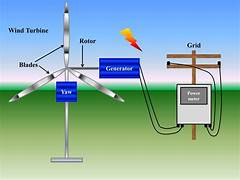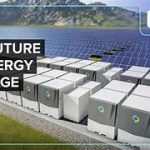Assessing the Efficiency of Wind Energy Technologies
The global demand for renewable energy has surged in recent decades, with wind energy emerging as one of the most promising alternatives to fossil fuels. Harnessing the power of wind to generate electricity is not a new concept, but advancements in technology have significantly increased its efficiency, making it a vital component of sustainable energy strategies worldwide. Despite its many advantages, wind energy technology faces efficiency-related challenges that must be addressed to optimize its potential.
This article explores the current state of wind energy technologies, evaluates their efficiency, and examines the factors that influence performance. It also delves into innovations aimed at improving efficiency and the broader implications of wind energy adoption.
1. Understanding Wind Energy Technology
Wind energy technology transforms kinetic energy from wind into mechanical power, which is then converted into electricity. The main components of a modern wind turbine include:
- Rotor Blades: Capture wind energy.
- Nacelle: Houses the gearbox, generator, and control systems.
- Tower: Elevates the turbine to capture stronger winds.
- Foundation: Anchors the turbine to the ground or seabed.
Turbines are typically classified as either onshore or offshore, each with unique advantages and challenges.
2. Factors Affecting Wind Energy Efficiency
A. Wind Speed and Consistency
The efficiency of wind energy generation is highly dependent on wind speed and consistency.
- Turbines operate optimally within a specific wind speed range, usually between 12 and 55 kilometers per hour.
- High variability in wind speed can disrupt consistent energy generation.
B. Turbine Design
The design of the turbine significantly impacts its ability to convert wind energy into electricity. Key considerations include:
- Blade Length: Longer blades capture more energy but require stronger materials.
- Aerodynamics: Optimized blade shapes reduce drag and increase efficiency.
- Generator Technology: Modern generators are designed to maximize power output even at low wind speeds.
C. Site Location
Selecting the right location is critical for efficiency. Ideal sites are characterized by:
- Consistently high wind speeds.
- Minimal turbulence caused by obstructions such as buildings or trees.
- Accessibility for installation and maintenance.
D. Energy Losses
Energy losses occur during conversion and transmission. These include:
- Mechanical losses in the gearbox and rotor.
- Electrical losses during energy transmission to the grid.
- Downtime due to maintenance or technical failures.
3. Measuring Wind Energy Efficiency
Efficiency in wind energy is measured in terms of the capacity factor, which compares the actual energy output to the maximum potential output if the turbine operated at full capacity continuously.
- Typical Capacity Factor: Onshore turbines average 30–40%, while offshore turbines can achieve up to 50% due to stronger and more consistent winds.
- Limitations: The theoretical maximum efficiency for a wind turbine, known as the Betz Limit, is approximately 59.3%. This means no turbine can convert more than this percentage of the wind’s kinetic energy into usable power.
4. Current Challenges in Wind Energy Efficiency
A. Intermittency
Wind energy is inherently intermittent, as it depends on weather conditions. This unpredictability can strain power grids and necessitate backup energy sources.
B. Material Limitations
Turbine components, especially blades, are subject to wear and tear due to constant exposure to environmental forces. Advanced materials are required to improve durability and efficiency.
C. Maintenance and Downtime
Frequent maintenance can reduce overall efficiency, particularly for offshore turbines where access is more challenging.
D. Land Use and Environmental Impact
Onshore wind farms require significant land areas, potentially impacting ecosystems and communities. Offshore farms mitigate some of these concerns but face higher installation and maintenance costs.
5. Innovations Improving Wind Energy Efficiency
A. Advanced Blade Designs
New materials such as carbon fiber composites and innovative blade shapes reduce drag and increase energy capture. Longer, lighter blades are also being developed to enhance efficiency without overloading the turbine structure.
B. Vertical Axis Wind Turbines (VAWTs)
Unlike traditional horizontal axis turbines, VAWTs can capture wind from any direction and are better suited for urban areas with turbulent wind patterns.
C. Floating Offshore Turbines
Floating platforms enable turbines to be placed in deeper waters where winds are stronger and more consistent. These platforms expand the potential sites for offshore wind farms.
D. Smart Turbine Technologies
Sensors and AI-driven systems are being integrated into turbines to monitor performance, predict maintenance needs, and optimize energy output.
- Example: Yaw control systems adjust turbine orientation to align with wind direction dynamically.
E. Energy Storage Solutions
Advancements in battery technology and grid integration systems help store excess energy generated during high wind periods, reducing the impact of intermittency.
6. Global Case Studies in Wind Energy Efficiency
A. Hornsea Project (UK)
The Hornsea wind farm, located off the coast of the UK, is the world’s largest offshore wind farm. It demonstrates the potential for offshore turbines to achieve high capacity factors and contribute significantly to national energy grids.
B. Alta Wind Energy Center (USA)
Located in California, the Alta Wind Energy Center is one of the largest onshore wind farms. Its strategic location and advanced turbines have made it a model for efficient wind energy generation.
C. Denmark’s Energy Transition
Denmark leads the world in wind energy utilization, with nearly 50% of its electricity generated from wind power. Investments in advanced turbine technology and grid integration have been key to its success.
7. Broader Implications of Wind Energy Adoption
A. Environmental Benefits
Wind energy produces no direct greenhouse gas emissions, making it a crucial tool in combating climate change. It also reduces reliance on fossil fuels, contributing to cleaner air and water.
B. Economic Opportunities
The wind energy sector creates jobs in manufacturing, installation, and maintenance. Offshore projects, in particular, drive significant economic activity in coastal regions.
C. Energy Independence
Harnessing local wind resources reduces dependence on imported fossil fuels, enhancing energy security.
D. Community Concerns
While wind farms provide environmental benefits, they can also face opposition from local communities due to concerns about noise, aesthetics, and potential impacts on wildlife.
8. Future Prospects of Wind Energy
The future of wind energy looks promising, driven by ongoing technological advancements and supportive government policies. Innovations in turbine design, materials, and energy storage will likely enhance efficiency and expand the scope of wind energy adoption.
In addition, international collaboration and investment in research and development will play a crucial role in overcoming the challenges associated with wind energy technologies.
Conclusion
Wind energy has proven to be an efficient and sustainable solution to the growing demand for clean energy. While challenges such as intermittency and material limitations persist, innovations in turbine design, smart technology, and energy storage are driving significant improvements in efficiency.
As the world transitions towards renewable energy, wind power will play an increasingly vital role in reducing carbon emissions, promoting energy independence, and fostering economic growth. By addressing current challenges and embracing emerging technologies, we can unlock the full potential of wind energy and contribute to a sustainable future for generations to come.


